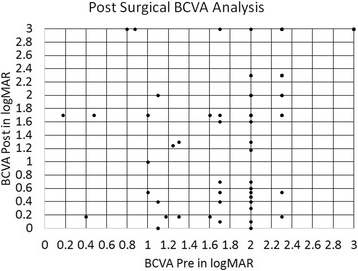Sensitivity, specificity and predictive values of anterior chamber tap in cases of bacterial endophthalmitis
- PMID: 28706959
- PMCID: PMC5506679
- DOI: 10.1186/s40662-017-0083-9
Sensitivity, specificity and predictive values of anterior chamber tap in cases of bacterial endophthalmitis
Abstract
Background: To assess the sensitivity, specificity, positive predictive value and negative predictive value of anterior chamber tap for the diagnosis of bacterial endophthalmitis on a population with high prevalence.
Methods: Retrospective, single centre, case series study. We reviewed all medical records with clinical diagnosis of bacterial endophthalmitis in our hospital from January 1st, 2000 to December 31st 2014. From each record, we documented general demographic data, best corrected visual acuity and vitreous and aqueous tap microbiological results. All cases were further divided according to the endophthalmitis aetiology to perform individual calculations of sensitivity, specificity, positive predictive value, negative predictive value, accuracy and prevalence. We used the results of the vitreous tap as the gold standard for diagnosis of bacterial endophthalmitis. We excluded those records in which the aqueous and vitreous samples were not taken simultaneously or had an incomplete microbiological report. Significance were assessed with chi squared statistics, with an alpha value of 0.05 for statistical significance.
Results: A total of 190 cases fulfilled the inclusion/exclusion criteria. Positive culture rate from vitreous samples was 64.74%. Positive culture rate from aqueous sample was 32.11%. Bacteria isolated from aqueous samples matched those isolated from vitreous samples 78.68% of the time. The overall sensitivity was 38.21%, specificity: 75.51%, positive predictive value: 79.66%, negative predictive value: 32.74% (p = 0.08). Subgroup analysis showed that anterior chamber taps in cases of post-surgical endophthalmitis had a moderate to low sensitivity (37.73%), high specificity (93%) and high positive predictive value (95%) (p < 0.04).
Conclusion: The sensitivity and specificity of anterior chamber tap are low and should not be used for critical therapeutic decisions in patients with suspected bacterial endophthalmitis. In cases of post-surgical endophthalmitis, the result of an anterior chamber tap could be used for therapeutic guidance, but only in conjunction with clinical presentation and in the absence of a better method for diagnosis.
Keywords: Anterior chamber tap; Aqueous humour; Aqueous sampling; Diagnostic test; Endophthalmitis; Sensibility; Sensitivity; Vitreous tap.
Conflict of interest statement
Ethics approval and consent to participate
The study was approved by the hospital’s Internal Review Board. Due to the study’s retrospective nature, no informed consent was needed.
Consent for publication
Not applicable.
Competing interests
The authors declare that they have no competing interests.
Figures
Similar articles
-
Diagnostic value of culture results from aqueous tap versus vitreous tap in cases of bacterial endophthalmitis.Br J Ophthalmol. 2022 Jun;106(6):815-819. doi: 10.1136/bjophthalmol-2021-318916. Epub 2021 Apr 9. Br J Ophthalmol. 2022. PMID: 33836991
-
Anterior chamber and vitreous concordance in endophthalmitis: implications for prophylaxis.Arch Ophthalmol. 2010 Sep;128(9):1136-9. doi: 10.1001/archophthalmol.2010.202. Arch Ophthalmol. 2010. PMID: 20837796
-
Onset of an outbreak of Bipolaris hawaiiensis fungal endophthalmitis after intravitreal injections of triamcinolone.Ophthalmology. 2014 Apr;121(4):952-8. doi: 10.1016/j.ophtha.2013.10.040. Epub 2014 Feb 5. Ophthalmology. 2014. PMID: 24507858
-
Post-traumatic endophthalmitis with retained intraocular foreign body - a case report with review of literature.Nepal J Ophthalmol. 2012 Jan-Jun;4(1):187-90. doi: 10.3126/nepjoph.v4i1.5875. Nepal J Ophthalmol. 2012. PMID: 22344021 Review.
-
Delayed-onset bleb-associated endophthalmitis: clinical features and visual acuity outcomes.Ophthalmology. 2002 May;109(5):985-91. doi: 10.1016/s0161-6420(02)00965-x. Ophthalmology. 2002. PMID: 11986108 Review.
Cited by
-
The Impact of Primary Treatment on Post-Traumatic Endophthalmitis in Children with Open Globe Injuries: A Study in China.Int J Environ Res Public Health. 2019 Aug 16;16(16):2956. doi: 10.3390/ijerph16162956. Int J Environ Res Public Health. 2019. PMID: 31426389 Free PMC article.
-
Long term analysis of microbiological isolates and antibiotic susceptibilities in acute-onset postoperative endophthalmitis: a UK multicentre study.Eye (Lond). 2025 Jun;39(8):1470-1475. doi: 10.1038/s41433-025-03673-w. Epub 2025 Feb 12. Eye (Lond). 2025. PMID: 39939392 Free PMC article.
-
Acute panuveitis after COVID-19 mRNA booster vaccination following cataract surgery.Am J Ophthalmol Case Rep. 2022 Oct 13;28:101726. doi: 10.1016/j.ajoc.2022.101726. eCollection 2022 Dec. Am J Ophthalmol Case Rep. 2022. PMID: 36267387 Free PMC article.
-
Factors Associated With Positive Microbial Culture in Patients With Endophthalmitis Based on Clinical Presentation and Multimodal Intraocular Sampling.Asia Pac J Ophthalmol (Phila). 2020 Jan-Feb;9(1):4-8. doi: 10.1097/APO.0000000000000263. Asia Pac J Ophthalmol (Phila). 2020. PMID: 31990738 Free PMC article.
-
Management Patterns and Outcomes for Intravitreal Injection-Related Endophthalmitis.J Vitreoretin Dis. 2021 Jul 28;6(3):188-193. doi: 10.1177/24741264211028435. eCollection 2022 May-Jun. J Vitreoretin Dis. 2021. PMID: 37008544 Free PMC article.
References
-
- Ng JQ, Morlet N, Pearman JW, Constable IJ, McAllister IL, Kennedy CJ, et al. Management and outcomes of postoperative endophthalmitis since the endophthalmitis vitrectomy study: the Endophthalmitis Population Study of Western Australia (EPSWA)'s fifth report. Ophthalmology. 2005;112(7):1199–206. doi: 10.1016/j.ophtha.2005.01.050. - DOI - PubMed
LinkOut - more resources
Full Text Sources
Other Literature Sources
Miscellaneous


